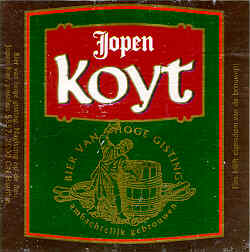It's an interesting style which, in its day, was pretty international. It was brewed in the Low Countries and parts of Northwestern Germany. Though, like many o these old styles, it appears to have changed character a few times.
In Holland (where Jopen brew a beer called Koyt today) it was a strong beer from mixed grains (wheat, oats and barley). It pre-dates the introduction of hops to the region and was originally a gruit beer. Later, much like Ale in Britain, it did contain a small amount of hops. Though sometimes these were left out.
In Münster Keut hung on for a remarkably long time, the last Keut brewer only dying in the late 19th century.
But you don't want to hear my bullshit. You want the recipe, don't you. Be warned that this a recipe for brewing at home, not on a commercial scale.
WHAT IS Keut? WHAT IS Altbier?
Keut, a Münsterland beer, was brewed according to a specific method. It used to be the house drink of the citizens. An old recipe from the period around 1600 reports on the production of Keut:
"To make Koet. Pour 7 cups of malt, 4 buckets of water and a good hand-full of wheat flour the previous evening into a kettle, where it is to be boiled. The next day boil it for 4 hours so that it boils down to about 1 bucket and becomes somewhat thick, but it must be stirred well so that it does not burn. Then it is poured into a basket with straw, over which a coarse linen cloth has been secured, so that it runs off clear. Then another four buckets of water and a handful of hops are boiled briefly, and poured through the same basket; it is then left to stand until it becomes lukewarm. Then add a good dose of yeast (1/4 litre) to the Koet, stir as with beer and cover it. The next morning, remove the yeast and fill into pitchers. Leave open for two days, then seal, place in each pitcher a »beschaten nagel« and a little white sugar, seal tightly and place in sand. "
So you don't imagine that »beschaten nagel« is a rusty nail, it should be pointed out that Krumbholtz explains this expression in his volume "Trade of the city of Munster," as "probably clove or nutmeg".
"Pinkus Müller. Der Singende Bierbrauer in Münster", by Walter Werland, 1966, page 53.
It's a bit of a weird recipe, as I can't see any mashing, just boiling. Not sure I'd give it a try.











































































5 comments:
And no hops or botanicals? Wouldn't it go off very quickly?
I am brewing today but I will not be making this. Ever. Still interesting stuff however.
The Beer Nut, yes, there are hops. A whole handful.
I've made a Koet before. I started with cold water and did boil it. HOwever, I took my time to get up towards boiling and it was basically is 'walking' step mash up through the different mash rests.
Quite pale, low bitterness, not a whole lot of anything other than beery goodness. I can see what it was so popular as it was so quick and easy to make. 4 day turn around or so. Anyone that brews should give this a try. Don't worry so much about types and volumes and use your own system. Ergo, I used a blue cup, a small bucket and my hands.
Ron,
Have you come across Grussink which is supposed to be similar to Koyt? That's one I haven't really been able to find anything solid on. Very ethereal as to what people want to call it.
Kristen, funny you should mention that. I've found the book that the Pinkus Müller history used as a source. It has a whole chapter on brewing, including this Koet recipe. I've not had chance to read it properly yet.
Post a Comment